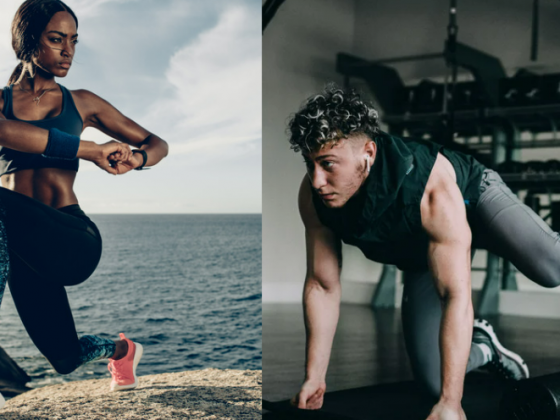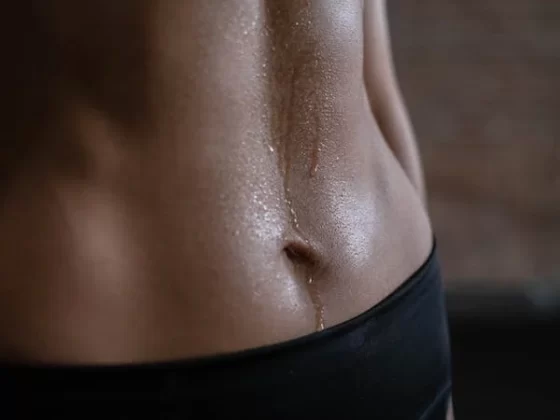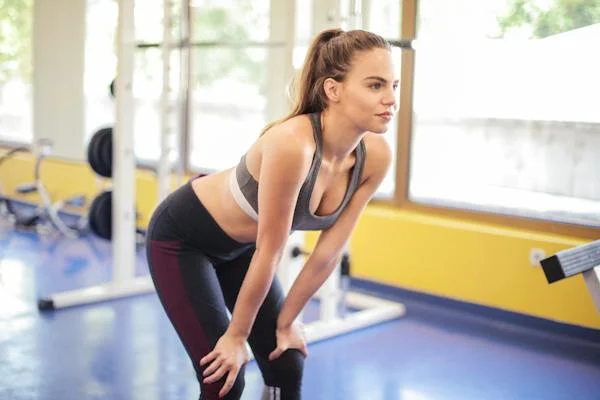
Feel empowered and confident with exercises designed to lift your bust naturally. Discover the secrets to a firmer and more sculpted upper body without taking drastic measures. Let’s delve into a transformative journey that combines fitness and self-confidence with the 6 bust-lifting exercises below.
Understanding the Anatomy:
The Pectoral Muscles
The pectoralis major and minor are the unsung heroes behind a perky bust. These muscles in the chest area play a pivotal role in shaping and supporting the breasts. Understanding their anatomy is crucial for targeting them effectively during your workout routine.
Importance of Chest Workouts
Contrary to common misconceptions, chest workouts are not just for men. Strengthening the chest muscles has a direct and positive impact on breast appearance for women. It’s time to debunk the myth that working out the chest negatively affects femininity and embrace the empowering benefits.
Equipment Essentials towards the 6 Bust-Lifting Bliss:
Resistance Bands
Resistance bands are your dynamic partners in this bust-lifting journey. These stretchy wonders offer a variety of resistance levels, making them ideal for toning and sculpting the chest muscles. From beginners to advanced fitness enthusiasts, resistance bands cater to all, providing a challenging yet adaptable workout experience.
Dumbbells: Your Lifting Allies
Dumbbells add a layer of sophistication to your exercise routine. The versatility of dumbbells allows you to target specific areas of the chest with precision. They also engage in stabilizing muscles, providing a comprehensive workout that goes beyond the superficial layers.
6 Bust-Lifting Exercises:
-
Push-Ups: Foundation of Strength
Although commonly labeled as a chest exercise, the push-up should be balanced with the other muscles it engages. In essence, the push-up falls under the category of compound bodyweight exercises, effectively targeting multiple muscles in the upper body.
Push-ups are the bedrock of any chest-focused workout. This fundamental exercise targets the chest and engages the core, shoulders, and arms. Beginners can start with modified versions, gradually progressing to standard push-ups for maximum impact.
The pectoralis major, the largest chest muscle, has a thick, fan-shaped structure beneath the breast tissue, serving as the primary mover during a push-up. Comprised of two heads, the clavicular head originates from the medial portion of the clavicle, while the sternocostal head originates from the sternum and upper ribs. Despite their distinct origins, both heads are inserted into the upper part of the humerus. During a push-up, this muscle facilitates the descent of the torso towards the floor and propels the body back to the initial position.
On the other hand, the pectoralis minor, a relatively smaller chest muscle situated beneath the pectoralis major, assumes a triangular shape. Originating from the front third through fifth ribs, it inserts onto the coracoid process—a small, hook-like structure on the front aspect of the scapula. The pectoralis minor stabilizes the scapulae throughout the push-up motion, ensuring proper shoulder and upper back alignment.
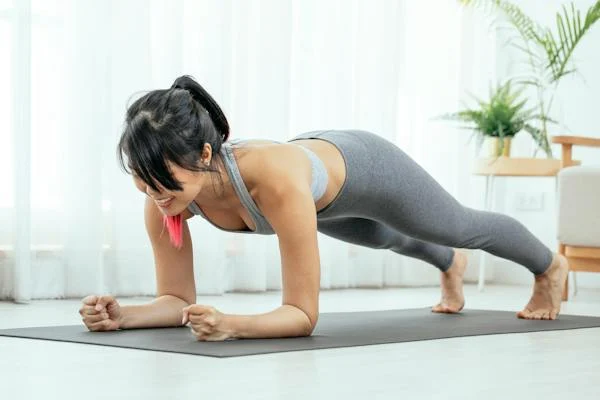
-
Chest Press with Dumbbells
The dumbbell chest press is a timeless and efficient upper body strength exercise aimed at enhancing upper body strength to boost exercise performance.
The chest press with dumbbells is a staple in any bust-lifting regimen. This exercise isolates and intensifies the work on the pectoral muscles, promoting controlled and focused movement. Mastering the correct form is critical to reaping the full benefits.
The dumbbell chest press, hailed as the epitome of upper-body strength exercises, has traditionally been executed with a barbell. However, opting for dumbbells presents notable divergences and advantages. Firstly, utilizing dumbbells necessitates increased shoulder effort to stabilize the ‘free’ weights, imparting a sensation of greater weight and reducing the risk of injury by necessitating lower loads. Moreover, lower loads encourage heightened attention to technique. Secondly, employing two separate weights permits enhanced feedback, aiding in the mitigation of muscular imbalances between the left and right shoulders/arms. Disparities in strength between sides, often stemming from poor technique or injury, can be discerned more effectively with dumbbells, allowing for targeted strengthening of weaker muscles.
Additionally, dumbbells facilitate a broader array of functional movements, encompassing single-arm and alternate-arm pressing techniques and the ability to alter grip and dumbbell position swiftly. These dynamics underscore the versatility and adaptability inherent in dumbbell exercises, enhancing overall upper-body strength and stability.
-
Incline Bench Press
Take your routine to new heights with the incline bench press. You target the upper chest by adjusting the angle, contributing to a well-rounded and lifted appearance. It’s a game-changer for those aiming to enhance the overall symmetry of the bust.
The bench can be inclined (or declined) to focus on specific regions of the pectoral muscles.
The incline bench can be adjusted to angles ranging from 30 to 45 degrees. An upright position engages the deltoids more while maintaining a closer angle of 30 degrees directs the focus primarily on the pectoral muscles.
While all bench press variations engage the shoulders to some extent, the incline dumbbell press emphasizes the anterior deltoids more than other forms. Moreover, the dumbbell version of the incline bench press typically imposes less strain on the shoulders than its barbell counterpart. This is attributed to the increased flexibility in positioning the dumbbells and shoulders, rendering it a more comfortable motion for many individuals.
The incline dumbbell bench press engages multiple joints, qualifying it as a compound exercise. It is advisable to prioritize compound exercises in a training regimen as they efficiently enhance strength across various muscle groups.
-
Butterfly Exercise
Butterfly flies add an elegant touch to your workout routine. This isolation exercise targets the outer chest, contributing to a balanced lift. Incorporating controlled and deliberate movements ensures optimal engagement of the muscles.
Explore a new dimension in your chest workout routine with the pec fly! This joint exercise, typically done on a machine known as the pec deck, is excellent for enhancing chest strength and definition. Whether male or female, incorporating this exercise into your routine can yield benefits: men can achieve increased width and definition, while women can experience effective toning.
The chest butterfly exercise, also known as a chest fly, entails extending your arms to the sides and bringing them back to the center of your chest.
You can do this exercise with dumbbells, resistance bands, or a chest fly machine, and it is a cornerstone of many resistance-training regimens due to its effectiveness in targeting the chest muscles.
The chest butterfly exercise, which targets the pectoralis muscles, utilizes a pushing motion to strengthen the chest, primarily emphasizing the pectoralis major. For men, this results in defined pec muscles, contributing to a balanced and toned torso appearance, while for women, it aids in lifting the chest. Post-exercise soreness in the chest may occur due to the limited endurance of larger muscle groups like the pectoralis major.
Additionally, the chest fly exercise strengthens synergist muscles, including those in the front of the shoulders and biceps, which support the chest wall and enhance stability in the chest region. Strengthening these muscles helps prevent shoulder injuries by providing adequate support to the shoulder joint.
Furthermore, incorporating variations like performing chest fly exercises while balancing on a stability ball challenges the pecs and synergist muscles. It engages the front and side core muscles, as the American Council on Exercise recommends for intermediate exercisers. Maintaining a straight back parallel to the floor during this variation is crucial to avoid injury and strain.
Finally, engaging the chest and shoulder muscles in movements like swinging and hitting a ball in golf or racquet sports can benefit from regular chest butterfly exercises, enhancing the power behind your swing and overall athletic performance.
-
Resistance Band Pull-Aparts
Resistance band pull-ups bring a dynamic element to your routine. Focusing on shoulder and chest engagement, this exercise enhances strength and flexibility. The continuous resistance challenges the muscles throughout the entire range of motion, fostering comprehensive development.
Moreover, aside from improving muscle mass and strength, band pull-aparts effectively counteract the adverse effects of poor posture.
Extended durations spent seated in front of a computer or using a phone often lead to a “geek neck,” characterized by a forward slumping of the head, upper back, and shoulders. This posture detracts from one’s appearance and can escalate into chronic neck and back issues with age. Exercises like band pull-apart, which entails retracting the shoulder blades, opening up the chest, and strengthening the rhomboids, serve as one of the most effective methods for rectifying poor posture. Moreover, they significantly contribute to shoulder stability by engaging the rotator cuff and other stabilizer muscles.
-
Plank Variations
Plank variations engage the core and contribute to chest stability and strength. These dynamic exercises promote a holistic approach to fitness, intertwining multiple muscle groups for an efficient and effective workout.
The plank, an increasingly popular isometric exercise, engages all core muscles and those in the back, shoulders, hips, and legs. Unlike traditional core exercises that rely on movement, the plank challenges the core to resist movement, promoting stability and strength by maintaining a stable body position over time. As an anti-core exercise, it enhances overall stability and can improve strength in compound lifts such as squats and bench presses.
Notably, planks offer a spine-friendly alternative for individuals who find traditional abdominal exercises like sit-ups and crunches taxing on their back. They effectively build core strength while facilitating proper engagement, thus making subsequent exercises more manageable. With various modifications available, including elbow planks, full planks, kneeling planks, and weighted planks, individuals can adjust the intensity and target specific muscle groups to suit their fitness goals and abilities.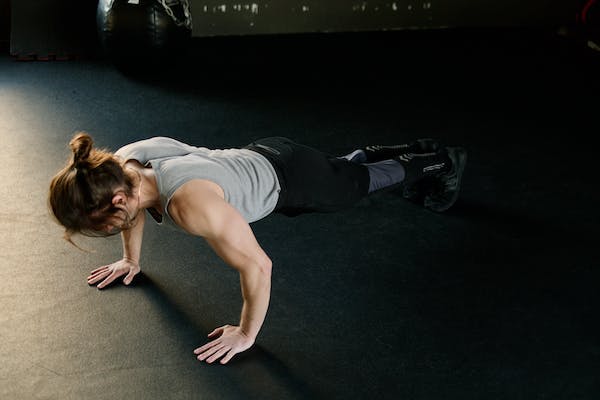
Form and Technique:
Maintaining Proper Alignment
The key to a successful bust-lifting routine lies in maintaining proper alignment. Ensure your body is in the correct position during each exercise to maximize muscle engagement and prevent unnecessary strain. Focus on the quality of each movement rather than quantity.
The Role of Breathing
Breathing is frequently disregarded but holds significant importance in any workout. Controlled breathing enhances muscle engagement, providing the necessary oxygen for optimal performance. Sync your breath with your movements, creating a harmonious and effective exercise rhythm.
Frequency and Consistency:
Establishing a Routine
Crafting a realistic and consistent exercise routine is paramount. Find a schedule that fits your lifestyle, ensuring you can commit to regular workouts. Consistency is the key to seeing tangible results and experiencing the transformative effects on your bust.
Tracking Progress
Keep tabs on your bust-lifting journey by implementing effective tracking methods. Whether through photos, measurements, or fitness apps, tracking progress fosters motivation and accountability. Celebrate small victories along the way to stay inspired.
Complementary Lifestyle Factors:
Nutrition Essentials
Optimal nutrition plays a vital role in bust health. Ensure your diet is rich in proteins, vitamins, and minerals to support tissue firmness. Hydration is equally important, contributing to overall skin elasticity and breast health.
Hydration Matters
Remember to underestimate the power of hydration. Adequate water intake supports skin elasticity, keeping your breasts and surrounding tissues supple. Make water your beverage to maintain optimal hydration levels and help your bust-lifting efforts.
Wardrobe Choices for Confidence:
Finding the Perfect Fit
Your choice of bra can either enhance or detract from the effects of your bust-lifting exercises. Invest in bras that provide proper support and lift, accentuating the natural beauty of your sculpted bust. A well-fitted bra contributes to both comfort and confidence.
Posture Awareness
Good posture is the silent hero of a confident appearance. Practice maintaining proper posture to showcase the benefits of your newfound confidence. Stand tall, shoulders back, and let your lifted bust complement your empowered stance.
Common Concerns and FAQs:
Addressing Sagging Concerns
Address common concerns about sagging by understanding the preventive nature of these exercises. Regular workouts contribute to the overall strength and tone of the chest muscles, acting as a natural support system for the breasts.
Adjusting for Physical Limitations
Modify and adapt the exercises to cater to individuals with physical limitations. Explore alternative movements that maintain the workout’s effectiveness while accommodating specific needs. Inclusivity guarantees that all individuals can start their bust-lifting journey.
Conclusion:
Wrap up your transformative journey towards bust-lifting bliss with a renewed sense of confidence. Empower yourself through consistent effort and embrace the holistic well-being of a sculpted upper body. Celebrate the strength and resilience of your body, radiating confidence in every step you take.
